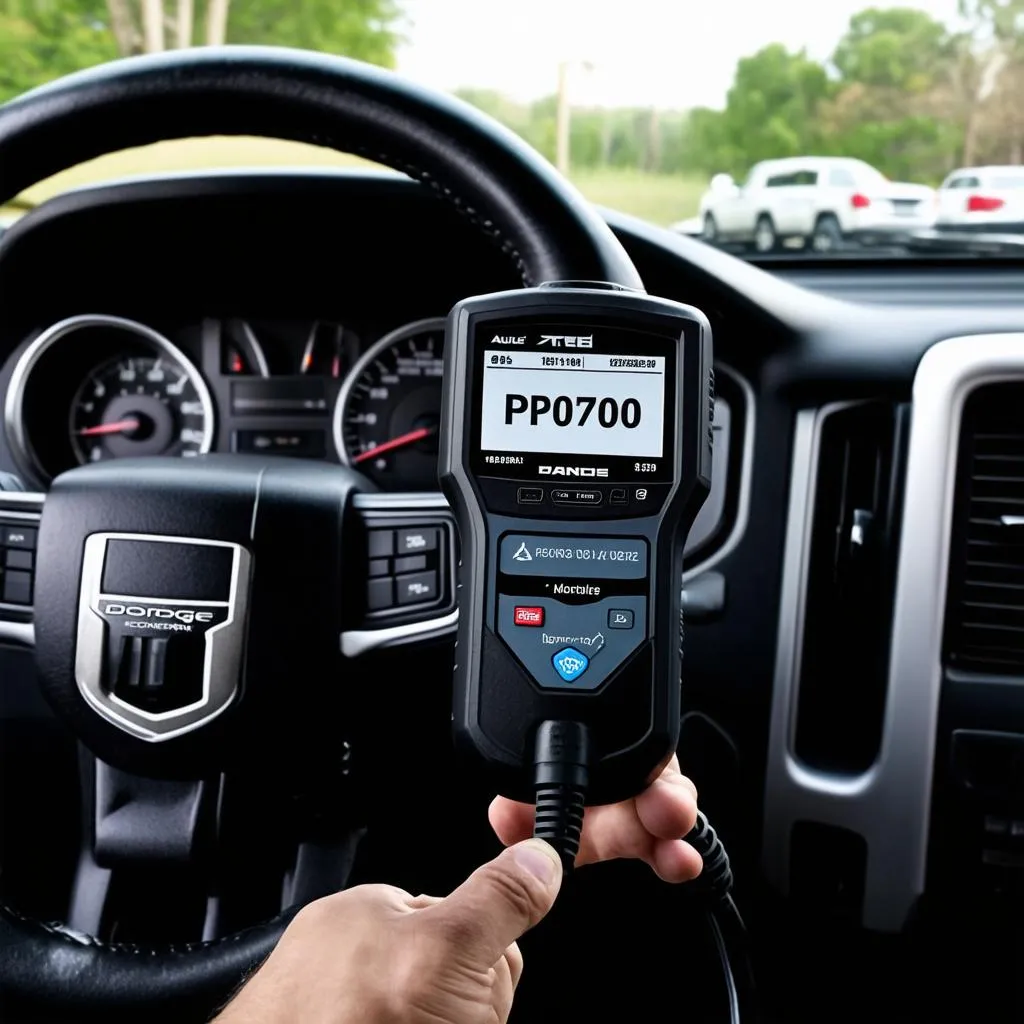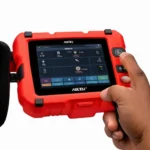Have you ever been cruising down the road, your trusty Dodge purring like a kitten, when suddenly the “check engine” light throws a wrench into your plans? And then, to add insult to injury, your Autel OBD2 scanner throws out a cryptic code: P0700. What does it mean? Is your transmission about to scatter itself across the asphalt? Don’t panic! We’re here to demystify the Autel OBD2 Dodge P0700 code and get you back on the road.
What Does Autel OBD2 Dodge P0700 Really Mean?
The P0700 code itself is like a distress signal from your car’s Transmission Control Module (TCM). Imagine the TCM as the brain of your transmission, constantly monitoring sensors and making adjustments to ensure smooth shifting and optimal performance. The P0700 code simply indicates that the TCM has detected a fault somewhere within the transmission control system. It’s not telling you what the specific problem is, just that there is one.
Think of it like this: you walk into your house and the alarm is blaring. That’s your cue that something is wrong, but you don’t know if it’s an intruder, a burnt pot on the stove, or just your cat feeling mischievous. The P0700 code is your car’s alarm system, alerting you to investigate further.
Decoding the Autel OBD2 Dodge P0700 Code
To pinpoint the root cause of the P0700 code, you’ll need to dig deeper using your trusty Autel OBD2 scanner. It’s time to channel your inner automotive detective!
Common Culprits Behind the P0700 Code:
- Faulty Transmission Range Sensor: This sensor tells your car’s computer what gear you’ve selected. If it’s malfunctioning, your car might not start, or it could shift erratically.
- Transmission Fluid Issues: Low fluid levels or dirty, degraded fluid can wreak havoc on your transmission. Imagine trying to run a marathon without water – not pretty, right?
- Wiring Problems: Worn, damaged, or corroded wiring can disrupt communication between the TCM and other components.
- Solenoid Malfunction: Solenoids control fluid flow within the transmission. A faulty solenoid can lead to harsh shifting or even prevent gears from engaging.
- TCM Issues: While less common, the TCM itself can sometimes fail, requiring replacement or reprogramming.
Unveiling the Mystery with Your Autel OBD2 Scanner:
Your Autel OBD2 scanner will become your most valuable tool in identifying the specific problem area. Here’s how:
- Read the Codes: Connect your scanner and read all stored codes. Don’t just stop at P0700, as other, more specific codes might be present, providing valuable clues.
- Check Live Data: The scanner’s live data stream will show you real-time information from various sensors, including transmission fluid temperature, vehicle speed, and gear position. Comparing these readings to normal values can help isolate the issue.
- Consult the Autel OBD2 Software: Autel’s software often provides detailed code definitions and possible causes, making troubleshooting easier.
A Holistic Approach: Blending Technology with Intuition
While technology plays a crucial role in modern car repair, don’t underestimate the power of intuition and experience. Just as a seasoned mechanic can often diagnose a problem by simply listening to an engine, paying attention to your Dodge’s behavior can offer valuable insights.
Trust Your Senses:
- Strange noises: Whining, grinding, or clunking sounds coming from the transmission are red flags.
- Shifting problems: Difficulty shifting gears, slipping gears, or harsh engagement can indicate a problem.
- Check Engine Light Behavior: Does the light flicker, stay on constantly, or illuminate only under certain conditions? These nuances can offer clues.
Seeking Expert Guidance:
While some DIY repairs are straightforward, transmission issues often require specialized knowledge and tools. If you’re uncomfortable tackling this repair yourself, don’t hesitate to seek help from a qualified mechanic.
Frequently Asked Questions about the Autel OBD2 Dodge P0700 Code:
Q: Can I still drive my Dodge with a P0700 code?
A: It’s not recommended. Driving with a transmission problem can lead to further damage and potentially leave you stranded.
Q: How much does it cost to fix a P0700 code?
A: Repair costs can vary widely depending on the underlying cause. A simple sensor replacement might cost a few hundred dollars, while a complete transmission rebuild could run into thousands.
Q: Can a transmission flush fix a P0700 code?
A: While a transmission fluid change is always good preventative maintenance, it’s unlikely to fix the underlying problem if the P0700 code is present.
Q: Is the Autel OBD2 scanner the best tool for diagnosing a P0700 code?
A: Autel OBD2 scanners are highly regarded for their accuracy and comprehensive diagnostic capabilities, making them an excellent choice for troubleshooting this code.
Related Questions:
- What are the most common Dodge transmission problems?
- How often should I change my Dodge’s transmission fluid?
- Can I use an Autel OBD2 scanner on other car makes and models?
Related Products:
- Autel MaxiCOM MK908P Diagnostic Scanner
- Autel MaxiSYS MS906BT Diagnostic Scanner
- Autel AutoLink AL619 OBD2 Scanner
Compatible Dodge Models:
- Dodge Ram
- Dodge Charger
- Dodge Challenger
- Dodge Durango
- Dodge Journey
Need Help with Your Dodge’s Transmission?
Don’t let a pesky P0700 code ruin your drive. For expert advice and assistance, contact our team of automotive specialists via Whatsapp at +84767531508. We’re here to help you get back on the road and enjoy a smooth ride!
We’re here to help you navigate the world of car repair, one code at a time!


